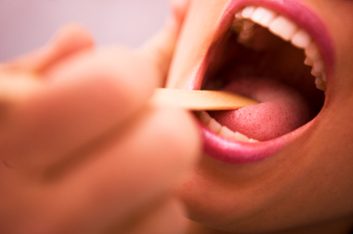
Keep your teeth happy
When many of us were growing up, the only advice we heard consistently about looking after our teeth and gums was to brush every day. We’ve come a long way in what we know about healthy mouths. Here are some of the latest trends in Canadian oral health:

Trend: Keeping your teeth for life
Thanks to fluoridated tap water and better access to dental health care, Canadians are keeping their teeth. Less than seven percent of adults have lost all their teeth, compared to 17 percent just two decades ago. Now, dentists say they’re seeing more enamel erosion. That’s damage to the hard outer surface of the tooth, caused by long-term exposure to acids.
Enamel erosion is irreversible and it can lead to sensitivity and tooth decay. How can you conserve your enamel? Cut back on acidic drinks like pop and alcohol. Brush your teeth after eating-but the new word is to wait 20 minutes, to give your saliva time to neutralize the acids in your mouth. If you grind your teeth, another factor in enamel erosion, talk to your dental care provider about how to prevent damage.

Trend: Making your mouth a health priority
Researchers are finding more and more links between oral health and the health of the rest of your body. Studies have demonstrated that people with gum disease or periodontal disease (which affects the tissues and structures around teeth) face an increased risk of cardiovascular disease. People with poorly controlled diabetes are more likely to have periodontal disease. Some research suggests that moms-to-be with unhealthy gums could risk a premature, low-birth-weight baby. And the World Health Organization notes that poor oral health can affect how well you eat and sleep, and even your self-esteem and psychological well-being.
“At the end of the day, oral health is important in its own right,” says Dr. Euan Swan, dental programs manager at the Canadian Dental Association in Ottawa. “But increasingly, researchers are demonstrating relationships between oral health and general health.”

Trend: Whitening (but it’s not for everyone)
Teeth aren’t naturally bright white. But don’t tell that to the hordes of Canadians who’ve been clamouring for tooth-bleaching treatments. We now have an impressive variety of whitening gels and strips on the market, as well as whitening toothpastes, gums and mouthwashes.
But we’ve learned whitening doesn’t suit every set of pearlies. If you have fillings, crowns or a few discoloured teeth, you may not get an even result with whitening. Whitening can be uncomfortable for some people, causing sensitive teeth or sore gums. The Canadian Dental Association recommends that pregnant women and children avoid using tooth-whitening products altogether.
Plus, whitening isn’t permanent, and long-term use hasn’t been fully tested. So take pause if you’re considering repeating the process every couple of years. Some experts suggest that using bleaching products repeatedly may lead to tooth pitting and nerve damage.
The best way to find out if whitening is right for you is to check with your dentist, before you pay for a promising-looking product.

Trend: Dental care for all Canadians
One in five Canadians has no dentist. Sometimes it’s because of financial barriers. In other cases, “people who are in isolated areas geographically have a hard time accessing dental care,” says Dr. Swan. There’s one dentist for roughly every 1,700 people in Canada, but in rural areas there’s only one for every 6,000 folks. Aboriginal Canadians, many of whom live in isolated communities, have four to five times as many cavities as the rest of the population.
Dental therapists, relatively new in this country, are trained to provide basic care, especially in the far north where few dentists are available. In other parts of Canada, free dental clinics or low-cost treatment at dental schools can be more attainable for families struggling with low income. But it’s not enough. The Canadian Dental Association recently released a position paper outlining more steps we need to take to ensure every citizen has access to oral care. “While most Canadians are in good oral health, there is a significant portion who need help in accessing basic dental care,” Dr. Swan notes.
Related:
• The oral-care products you really need
• Tooth care on the go
• Quiz: How much do you knabout your mouth?

Trend: Dental care for all Canadians
One in five Canadians has no dentist. Sometimes it’s because of financial barriers. In other cases, “people who are in isolated areas geographically have a hard time accessing dental care,” says Dr. Swan. There’s one dentist for roughly every 1,700 people in Canada, but in rural areas there’s only one for every 6,000 folks. Aboriginal Canadians, many of whom live in isolated communities, have four to five times as many cavities as the rest of the population.
Dental therapists, relatively new in this country, are trained to provide basic care, especially in the far north where few dentists are available. In other parts of Canada, free dental clinics or low-cost treatment at dental schools can be more attainable for families struggling with low income. But it’s not enough. The Canadian Dental Association recently released a position paper outlining more steps we need to take to ensure every citizen has access to oral care. “While most Canadians are in good oral health, there is a significant portion who need help in accessing basic dental care,” Dr. Swan notes.
Related:
• The oral-care products you really need
• Tooth care on the go
• Quiz: How much do you knabout your mouth?
